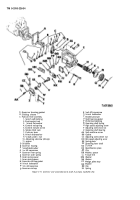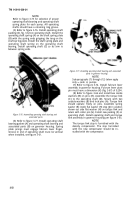TM-9-2910-226-34 - Page 95 of 208
TM 9-2910-226-34
(5) Check sliding sleeve (B) against the limits
specified in the repair standards (para 3-60) and
replace the sleeve when it does not meet these
requirements. Inspect the bearing face of the sleeve
to determine the depth of any indentations. When
indentations exceed 0.008 -inch, replace the sliding
sleeve.
(6) Examine the operating shaft bearing (Z) for
burs, nicks, and scratches on the gasket surface and
hub diameter. Repair minor burs, nicks, and
scratches with a fine mill file or crocus cloth. Replace
the operating shaft bearing when any of these
conditions are excessive. Check the operating shaft
bearing against the limits specified in the repair
standards (para 3-60) and replace the bearing when it
does not meet these requirements.
(7) Inspect the operating shaft (FF) and shaft
spring plate (EE) for wear and replace any worn part
or parts. Check parts against the limits specified in
the repair standards (para 3-60) and replace parts
when they do not meet these requirements. Examine
the ends of the operating shaft spring (W) for wear
and indentations. When the spring ends are worn or
have indentations that exceed 0.004-inch, replace the
spring. Generally if the shaft is replaced, the bearing
plate is also replaced.
(8) Inspect the smoke limit cam (C-6) for wear
patterns and any other visible damage. Replace the
part when either condition exists.
(9) Inspect fuel control rod (C-2) and control rod
pin screw (C-5) for wear patterns and any other
visible damage. Replace parts when either condition
exists.
NOTE
Sub-paragraphs (10) and (11) below apply
only to code A injection pumps.
(10) Refer to figure 3-66. Inspect the operating
shaft torque link pivot pins (E) and shaft assembly
(D) for wear and replace shaft assembly if any part is
worn, Check shaft against the limits specified in the
repair standards (para 3-60).
NOTE
If operating shaft is replaced, replace shaft
bearing.
(11) Refer to figure 3-66. Inspect pin slots, and
stop pin on torque link (C) for wear, damage and
cracks. Replace torque link where showing wear or
damage.
c. Assembly.
Assemble the governor as follows:
NOTE
Refer to figure 3-72 for identification of
governor housings. All pumps use a pipe
plug in the bottom of the governor housing
as shown.
(1) The parts in the universal governor and
linkage repair kit 5702685 are listed and illustrated
in appendix B. The parts applicable to this governor
and linkage must be used in repair of the governor.
Figure 3-72. Identification of governor housings.
NOTE
Refer to (2) below for assembly instructions
on the fulcrum lever used on code A, B, C,
D, E, and F series pumps. Refer to (3) below
for instructions on code G pumps.
(2) Refer to figure 3-67. Code A pumps must
have a fulcrum lever pivot pin dimension (X) of
0.204. Code B, C, D, E, and F pumps must have a
fulcrum lever pivot pin dimension (X) of 0.165.
Install setscrew (J). (Setscrew (J) is not used on code
C and D pumps. ) Assemble spacer (K) (spacer (K) is
used only on code A pumps) and smoke limit cam
(H) on control rod pin screw (G) and install the
control rod pin screw on the fulcrum lever. Secure
with lock washer (F) and hex nut (E) after setting
the smoke cam angle per table in figure 3-73. Use
improvised tool (figure 2-1 ) to set cam angle. Torque
tighten hex nut (E) to 50-60 inch-pounds. Install
spring (D) and washer (C) on control rod pin screw
and install control rod (B). Secure with self-locking
nut (A) torqued to 12 14 inch pounds.
(3) Refer to figure 3-67. Code G pumps should
have a fulcrum lever pivot pin dimension of 0.165.
Install setscrew (T) and hex nut (S). One or two
threads of setscrew should extend beyond hex nut
for preliminary adjustments. Assemble smoke limit
cam (U) on control rod pin screw (Q) and intall the
control rod pin screw on the fulcrum lever. Secure
with lock washer (R) and hex nut (P) after setting
the smoke cam angle per table in figure 3-73. Use
improvised tool (figure 2-1 ) to set cam angle. Torque
tighten hex nut to 50-60 inch-pounds. Install fuel
control rod (N), flat washer (M) and cotter pin (L).
3-49
Back to Top




















